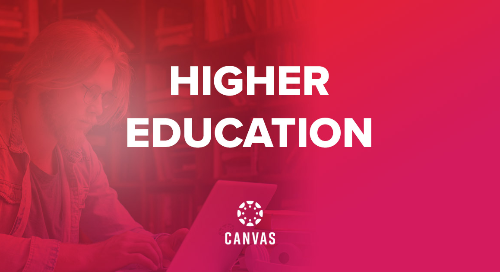
By now, we’ve established that change is inevitable in higher education. But it’s not only (a lack of) funding and new government strategy which is driving a fundamental shift in focus.
A new generation of students is beginning to enter university life. Generation Z, defined by some as “smarter than Boomers and more ambitious than Millennials,” refers to people who were born after 1995 into a world where the Internet, social media and mobile technology have always existed - and who have subsequently borne witness to significant financial, economic and environmental turmoil.
Commercial industry has long been aware of Gen Z and is committed to attracting and retaining these young employees by fostering a more flexible, mobile, and connected work environment. Business leaders recognise that to be part of this new generation is to be global, social, visual, and technological. Ambitious and eager to enact change, Gen Z can prove to be influential beyond their years in the workplace.
But are universities ready for this influx of digitally savvy, collaborative, and entrepreneurial learners? Or are they lagging behind commercial counterparts?
The answer, on both counts, is probably that ‘some are’. As edtech leaders we naturally see some great examples of the most tech savvy and forward looking institutions, working in partnership with students to deliver transformative education. At Fontys ICT, for example, students are able to define their own goals and build their own competence profile, finding content that fits these needs. Students are empowered to be owners of their own content, the pace of their learning, their own style and performance, and progression data.
But while there are some examples of HE institutions fully embracing this crucial opportunity to re-invent themselves, the structure and processes of others have remained largely unaltered - and the lecture theatre, rote learning and an exam culture is still very much the priority.
So how do these academic leopards change their spots? And why should they do so?
A new approach to student engagement
Meeting expectations is crucial. Students joining courses in September 2019 (or those in classes now) will likely have had access to 4K televisions, the latest game consoles, virtual reality tech, augmented reality applications and devices that can stream video quickly whenever and wherever they like. So the pressure is on for universities to provide the same experience students get at home, if not a better one. iPads in every lecture, laptop loans, and support for bring your own device (BYOD) schemes are all ways of working which are supported by many.
But we’d urge a move away from talk of tablets and laptops defining many tech strategies, to an understanding that hardware is just one piece of a rich tech ecosystem.
For us, technology doesn’t mean iPads or even apps. Technology means systems that can improve and democratise teaching and learning, from video to virtual learning systems to data-capture and analysis tools. Simply giving every student an iPad isn’t going to improve the learning experience in any lasting way, no matter how much students demand them, or how laudable your intentions are.
And so, a new generation means more than just new tech - it requires the need to rethink how we engage with our students. University leaders who understand that it’s the connection between digital engagement and student experience which leads to real change, are those who will not just address the challenges but thrive off them. Student-focused efforts, led via savvy social media practitioners, is the real key to success.
We know that Gen Z values a steady stream of information, insights and recommendations to inform decisions and guide experiences. And so, pairing peer learning and hyper charged collaboration, enabled by tools like Instructure’s learning management platform (Canvas), is a significant step forward in meeting these needs. In fact, the innovation and digitalisation officer from Frankfurt School of Finance and Management tells us “Canvas mirrors the online experience of slick, social media platforms, which students are comfortable and happy using. Ease of use and good design can’t be underestimated in technology, and Canvas has that in spades.”
Support for self directed study
Looking again to industry, LinkedIn Learning’s research suggests that just 20 percent of learning and development practitioners plan to offer self-directed learning experiences for Gen Z. Although perhaps less prevalent than in industry, the same is sometimes said of universities, with education leaders often skeptical about the impact of ‘self-serve’ learning given the amount of freedom it allows.
But as the shelf-life of skills shrinks and the need to optimise the use of AI increases, there is unprecedented pressure to embrace continuous learning, it’s time to open up to new approaches that work for different groups. And Gen Z wants to choose what to learn and how they want to learn it in a way that feels right to them. Giving them the freedom to learn on their own while guiding them on the type of skills required may create a more supportive learning journey that Gen Z desires, as well as improving motivation, learning gain and even outcomes.
And finally, beyond the ‘hard’ or subject specific skills on which university education focuses, the softer skills (like collaboration, management and applied knowledge) must not be ignored - as Gen Z attempts to navigate a changing world of work. A high portion of this generation is cognisant that they may be studying for jobs that might not exist in ten years, and so value a polymath mindset, capable of shifting alongside the working world.
Of course all this demands a shift in mindset from teachers. Educators no longer have to impart tech-enabled learning in a linear fashion, but can use new platforms as a guide - helping students traverse and consume information in a considered and meaningful manner.
So are you ready? How is your institution working embracing technology (not just gadgets) and how can this digital drive grease the wheels of success to recruit and retain premier students? Visit our website to hear experiences of other institutions and to find out how we can help.
Keep learning,
The Canvas Team
Related Content
 Upskilling and Reskilling Preparing Students for a Modernized Workforce.png
Upskilling and Reskilling Preparing Students for a Modernized Workforce.pngBlogs
 skills-forward.jpg
skills-forward.jpgBlogs
 closing-the-skills-gap.jpg
closing-the-skills-gap.jpgBlogs